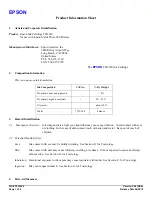
Reverse
idle
phase: Set to LOW then to HIGH by the
peripheral device to generate an interrupt
which informs the host of data ready.
ECP Mode:
Used in the closed loop with HostAck
(nAutoFd) to transfer data from the
peripheral device to the host.
EPP Mode:
Used by the peripheral devices to interrupt
the host. This signal is active LOW, and
triggered at the positive edge.
PtrBusy/PeriphAck/nWait (Busy): Driven by the peripheral devices.
Compatibility Mode:
Driven to HIGH to show that the peripheral
devices are not ready for data reception.
Negotiation phase:
Reflects the current state of the peripheral
device forward channel. When the host
strobes the interface extensibility request
byte to peripheral devices, PtrBury is set
to some devices.
Reverse data transfer
phase:
Nibble Mode: Data bit 3, then 7, then for-
ward channel busy state.
Byte
Mode: Forward channel busy
state
Reverse idle phase:
Forward channel busy state
ECP
Mode:
This signal is used by the peripheral
devices to control the forward flow.
PeriphAck also supplies command infor-
mation in the reverse direction.
EPP Mode:
This signal is driven to inactive as a posi-
tive response from the peripheral device
which shows the completion of data or ad-
dress transfer. This signal is active LOW.
It is driven to active to show that the
device is ready for transfer of the next ad-
dress or data.
AckDataReq/nAckReverse (PError): Driven by peripheral devices.
Compatibility Mode:
Driven to HIGH by the peripheral device to
show an error occurrence in the paper
path. The meaning of this signal differs
depending on the peripheral device.
Negotiation phase:
Set to HIGH to show the 1284 support.
Then it follows nDataAvail (nFault).
Reverse data transfer
phase:
Nibble Mode: Data bit 3, then 6.
Byte Mode:
Same as nDataAvail
(nFault).
Reverse idle phase:
Set to HIGH until the host requests for
data transfer. Then it follows nDataAvail
(nFault).
ECP Mode:
Set to LOW by the peripheral device to
confirm nReverseRequest. The host
depends on nAckReverse to determine
when to drive the data signals.
EPP Mode:
This signal is not used in the EPP Mode.
Xflag (Select): Driven by the peripheral devices.
Compatibility Mode:
Set to HIGH to show that the peripheral
device is in the online state.
Negotiation phase:
"Xflag" means an extension flag. It is used
by the peripheral device to respond to the
extensibility request byte sent by the host
in the negotiation phase. The signal level
used to show the positive response to
each extension byte.
Reverse data transfer
phase:
Nibble Mode: Data bit 1, then 5.
Byte
Mode: Same as the negation
phase.
Reverse idle phase:
Same as the negotiation phase.
ECP Mode:
Same as the negotiation phase.
EPP Mode:
This signal is not used in the EPP Mode.
HostBusy/HostAck/nDStrb (nAutoFd): Driven by the host.
Compatibility Mode:
The interpretation of this signal differs
depending on the peripheral devices.
Set to LOW to set a printer to the auto line
feed mode.
It is also used as the 9th data parity or the
command/data control bit.
Negotiation phase:
To request the 1284 mode, 1284Active
(nSelect IN) is set to HIGH and this signal
is set to LOW.
Then it is set to HIGH after the peripheral
device sets PtrClk (nAck) to LOW.
Reverse data transfer
phase:
Nibble Mode: Set to LOW to show that
the host is ready to receive
data from the peripheral
devices. Then it is set to
LOW to confirm the nibble
reception.
Byte Mode:
Same as the Nibble Mode
to confirm the byte re-
quest. Following the
reverse channel transfer,
the interface is transferred
to the idle phase when
HostBusy (nAutoFd) is set
to LOW and there is no
data in the peripheral
devices.
Reverse idle phase:
To enter the reverse data transfer phase
again, it is set to HIGH in response to Ptr-
Clk (nAck) LOW pulse. When the 1284
Active (nSelect IN) is set to LOW and this
signal is set to HIGH, the 1284 idle phase
is aborted and the interface returns to the
Compatibility Mode.
ECP Mode:
This signal is driven by the host to control
the flow in the reverse direction. Used in
the interlock handshake with PeriphClk
(nAck). HostAck also provides command
information in the forward direction.
EPP Mode:
This signal is active LOW, and used to
show the data cycle.
Peripheral logic High: Driven by the peripheral devices.
Set to HIGH to show that all the other signals sourced by the
peripheral devices are valid. Set to LOW to show that the peripheral
device power is off or that the interface signal of the peripheral device
drive is invalid.
The peripheral device maker may use this signal to 5V power
to the connected device, but it is not vitally necessary.
In all cases, the current of the peripheral device must be limited to
max. 1.0A. The circuit must be provided to drive the logic LOW level
of this signal when the peripheral device power is turned off.
nReverse Request (nInit): Driven by the host.
Compatibility Mode:
To reset the interface and forcibly return to
the Compatibility Mode idle phase, this
signal as well as the 1284 Active is set to
LOW.
SHARP SERVICE MANUAL JX8200SM [13] ELECTRICAL SECTION
13 – 27
Содержание JX-8200
Страница 201: ...14 2 ...
Страница 202: ...14 3 ...
Страница 203: ...14 4 ...
Страница 204: ...14 5 ...
















































